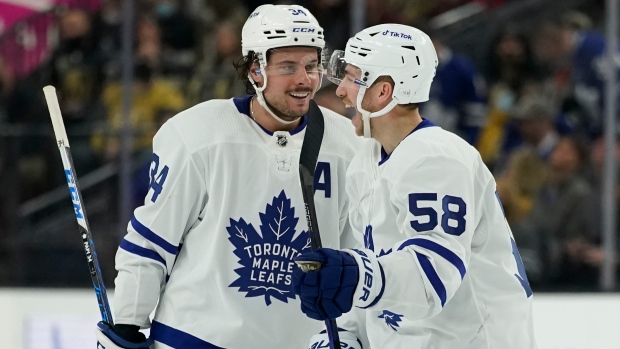Jan 24, 2022
This year feels different for Maple Leafs
Toronto looks comparable (and in some cases, better) than the top teams in the league, something the numbers have been reticent to say in seasons past, Travis Yost writes.
By Travis Yost

Could this be the year for the Toronto Maple Leafs?
That’s not something I have written during my tenure at TSN because for as long as the new-era Maple Leafs have existed, there has always been a fundamental flaw. Unreliable goaltending, a porous blueline, star players going quiet during pivotal stretches – the organization and fans have seen it all.
There is no doubt that Toronto is one of a handful of teams in this year’s Stanley Cup race. Most sportsbooks see five genuine favorites – Toronto joined by the Colorado Avalanche, Tampa Bay Lightning, Vegas Golden Knights, and Florida Panthers, with plenty more competition within the Eastern Conference.
But this year feels a bit different.
One of the things I’ve been paying attention to in recent years is what I’ll call Players Above Break-Even, or the percentage of rostered players carrying expected goal rates north of 50 per cent. It’s a simple but an effective approach for analyzing full roster performance; it simultaneously captures the ability of top-end players to dominate their opponents, and weeds out top-heavy teams that generally struggle in the postseason against better competition.
The correlation between expected goal rates and actual goals (and by extension, wins and losses) is substantial. But expected goals allow us to control for goaltending volatility; they also help us avoid the pitfalls of chasing teams with ripping-hot shooting luck.
Players Above Break-Even is a lot like market breadth for those in the securities world. With that perspective, consider where Toronto falls so far this season:

Toronto is the only team in the National Hockey League whose entire roster has outplayed the competition over the course of the full season. That’s it. And you’ll notice the group of teams that are right in trail – the likes of the Panthers, Hurricanes, and Lightning – are essentially all of the teams who are regarded as powerhouses of the sport.
The bottom right quadrant is where you want to be, and outside of the teams who have received impeccable goaltending come April and May, it’s the area the Stanley Cup winner tends to emerge from.
Let’s take a look at just those four teams, because by and large, that will be Toronto’s competition going forward. Let’s compare expected goal rates across the teams, this time looking player-by-player:

That’s an awful lot of blue, indicating the player was above break-even, be it by expected goals or net-goals over the course of the season. All four of these teams are incredibly deep and very few players (Nick Ritchie, Joe Thornton, Zach Bogosian) have actually been on the wrong end of the puck through the first half of the season.
One of the interesting things is you can pick up on the nuance within each team relatively quickly. The Lightning may not be the most dominant skater group in the league, but when you bring in Andrei Vasilevskiy and the goaltending component, they look ferocious – the Lightning’s entire roster is above water in straight goal differential, which is remarkable at this point of the season.
The Maple Leafs are in a similar boat: goaltender Jack Campbell is stopping 92.7 per cent of shots faced this year, which means Toronto’s talented skater group can win most games on pure shooting volume. (Carolina, meanwhile, is the most puck-dominant team in the league; offset by average goaltending from the combination of Frederik Andersen and Antti Raanta).
It would be unwise to dismiss the potential of any of these teams – at points this season, all of them have looked like the best team in the league. But unlike prior seasons, Toronto actually looks comparable (and in some cases, better) than the top teams in the league. Something the numbers have been reticent to say in seasons past.
To recap: Toronto’s top-end talent has dominated all season long, there is incredible roster breadth, the blueline is reliable enough, and Jack Campbell has been a godsend by way of the Los Angeles Kings.
There is plenty of season left but there’s no reason not to be excited about this Toronto team. And if you don’t want to believe me, believe the math. The math that has them as the best Maple Leafs team in the modern era (2007-22):

Data via Evolving Hockey, NHL.com, Natural Stat Trick

